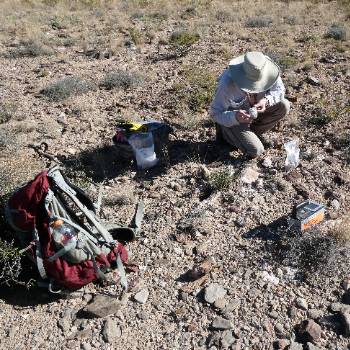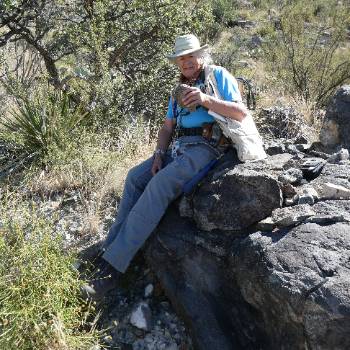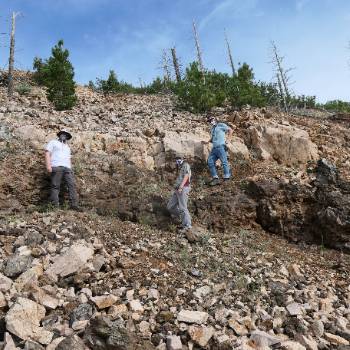Field Work Aims To Locate Critical Mineral Deposits
Dec. 14, 2022

SOCORRO, N.M. – They are key components in solar panels, electric cars, wind turbines, and electronics of all kinds – critical minerals are essential to our modern life and economy as well as for our national defense. Several grant projects underway at the New Mexico Bureau of Geology and Mineral Resources aim to identify locations and geological formations around the state where critical minerals can be identified and evaluated as a potential mineral resource for future development. The information and data collected will be publicly available for everyone seeking information about these resources.
Virginia T. McLemore, Ph.D., principal senior economic geologist and minerals outreach liaison for the Bureau, is overseeing the work of students and staff on these grant projects, which are funded by either the U.S. Geological Survey or the U.S. Department of Energy. It’s her job to look for critical mineral occurrences in the state, work with colleagues to understand the geologic conditions for mineral formation, and update state inventories of these resources.
“You just aren’t going to have life as we know it without critical minerals, especially the Rare Earth minerals” she said. “What we want to do is look at deposits throughout New Mexico and see where in the system these critical minerals reside.”
The critical minerals grant projects include:
- Creating databases of known occurrences of critical minerals in New Mexico. Dr. McLemore said the Bureau is developing a plan for how the state will address research on critical minerals.
- Another project involves a team of students and staff going into two areas of the state to develop detailed maps. The Cornudas Mountains in Otero County between El Paso and Carlsbad and the Gallinas Mountains in Lincoln County north of Carrizozo are the two sites targeted for the detailed remapping projects, which also involve chemical analysis and electron microprobe work.
- Another project is having staff and student researchers to evaluate the Laramide-Pophyry copper deposits in New Mexico, by seeking occurrences of critical minerals associated with these deposits. When the copper is mined, the ore goes to a mill and a mineral concentrate is created before the copper is sent to a smelter and then to a refinery to produce pure copper. The waste that comes off the concentrate can be processed further for critical minerals.
- Another grant project has researchers looking for critical minerals in mine waste, including tailings piles and mine dumps. Dr. McLemore chose three mining districts for this research: The Black Hawk District in Grant County in the Burro Mountains, the Steeple Rock District in Grant County on the border with Arizona north of Lordsburg, and in the Copper Flat District in Hillsboro.
- A final project funded by the U.S. Department of Energy involves looking at rare earth and critical minerals in coal deposits, particularly in the San Juan and Raton basins. Researchers will visit coal fields to collect samples, and perform chemical analysis for critical minerals in coal seams. A second phase of the project will examine whether critical minerals can be extracted from the coal ash waste products. In addition, researchers are examining critical mineral concentrations in clinker deposits – hard, brick-red material that was once coal but caught fire naturally via a lightning strike, spontaneous combustion, or forest fire. Lastly, another area of focus are the sandstone placer deposits that represent shorelines formed along the margins of ancient swamps or lakes. These environments are known for higher concentrations of heavy minerals and may have higher concentrations of rare earth minerals.

Dr. McLemore said that after all of this field and analytical work, Bureau researchers will have a new inventory of critical mineral occurrences found in the different geological units in New Mexico. The projects also help train students in field work and research methods, and help prepare them to present posters, abstracts, and papers at meetings, conferences, and on campus at the Student Research Symposium.
“The more that’s known about critical minerals – how they form and where – the more likely they can be extracted and used for different applications,” Dr. McLemore said.

“It’s good to develop a model for exploration and that’s what these projects ultimately do,” she said. “By doing this field work and developing these geologic models, we can identify other areas in the state where we can go and examine and look for these deposits.”